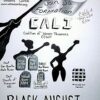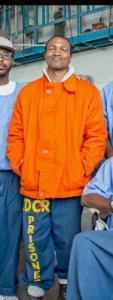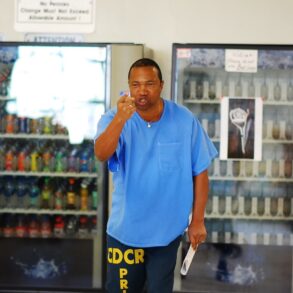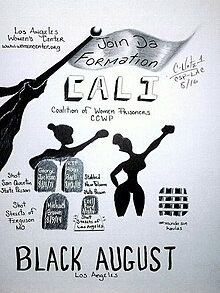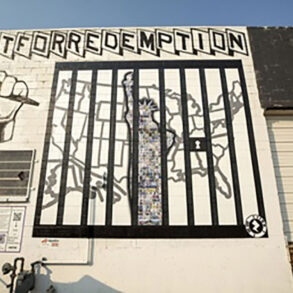America’s most prolific prisoner-artist, Donald “C-Note” Hooker is an internationally known poet, playwright, painter, musician, and King of Prison Hip Hop. His works have been performed, exhibited, and sold, throughout the United States from New York City to Los Angeles. He surpassed Chinese prisoner-artist Ai Wei Wei in Google Search, when asked, “Who is America’s most prolific prisoner-artist?” Ai Wei Wei’s works sell in the six-figures. Two of his works are ranked in the top 30, in Google Search Images, when asked, “Who is the world’s most prolific prisoner-artist?” His work Birth Of A Salesman, is ranked 16th (#1 U.S.) Ai Wei Wei’s Traditional Chinese Dragon, is ranked 26th (#3 U.S.), and C-Note’s Mprisond, is ranked 28th (#6 U.S.), in the world. He’s written for Prison Action News, California Prison Focus, and has been in People Magazine, Public Television-Los Angeles (KCET), and ABC-Los Angeles (KABC). His work has also been recognized by the Governor of California, Mayor of Los Angeles, and the California State Senate. C-Note is a part of the Restorative Justice Movement. A social advocacy movement that raises awareness of the American mass incarceration problem, and how to bring reforms to ending it. The role of the prisoner-artist is instrumental in raising this public consciousness. Prison Art is one of the methods and means of raising funds for legislative reform, prisoner reentry programs, and to support families with a loved one behind bars. If the 2.2 million American prison population were a city, it would be the fourth largest behind New York, Los Angeles, and Chicago, all known for very vibrant art scenes. There are lots of new and exciting forms of art being developed behind bars to which C-Note is a part of, like “Prison Hip Hop,” “Spoken Floz,”, Neo Jim Crow Art and “Paintoems”.
In 2014, C-Note began a Prisoner Art Collective known as Neo Jim Crow. Neo Jim Crow Art is a prisoner led art movement by incarcerated African Americans during this period in the United States known to Black Americans as the New Jim Crow. The impetus for this movement is the Jewish Holocaust imprimatur to “Never Forget,” and the little to no digital recognition that art had been created during the first Jim Crow era.
In 2015, he wrote and starred in the opening act to the critically acclaimed prison drama, Redemption In Our State Of Blues. This work was instrumental in leading to the “BREAK IT TO MAKE IT (BITMI): Busting Barriers for the Incarcerated Project, Los Angeles, California.” A first in the nation prison reentry project. It provides two years of free housing from the Los Angeles Mission . Two years of free education from the Los Angeles City College, and participation in the jails to jobs program of actual paid theatrical work with the theater group, The Strindberg Laboratory.
In 2016, C-Note created the Paintoem. Paintoems are poems inspired by paintings or drawings, or paintings or drawings inspired by poems, combined together as a single work of art. Once created, the public has free use rights to these works as long as the artist or artists are acknowledged. They have been primarily used for prisoner art exhibits and prisoner publications. Both use visual and literary works by prisoners for their exhibits or publications.
Our interview takes place at the California State Prison-Los Angeles County, in Lancaster, California, in the Mojave Desert.
DRPA: Good morning, C-Note how are you?
C-Note: Excellent.
DRPA: Now we asked you to bring some art, you initially only brought two pieces, and then went back and grab four more, why was that?
C-Note: Well, I thought about it, and these other pieces would add to the richness of the conversation and let you know what kind of work I do and how I utilize these works.
DRPA: So what piece would you like to start off with first?
C-Note: “Colored Girl (Highlighted)”
DRPA: I notice it’s a print, and it’s called “Highlighted,” does that mean there is more to this piece?
C-Note: Yes, I still have the original that I hope to give and have exhibited in the National Museum of African American History and Culture, on the National Mall, in Washington D.C.. It’s a very significant piece, for one, it’s a very beautiful piece. It is a piece, and its beauty was made on an accident. In other words, I have no clue how it came about. I work in a medium that doesn’t get recognized, I work in wax. So I put all this different kind of wax together and different formulae to dissolve the wax on paper. I had a model. A picture out of a magazine. But I’m not confident as an artist so I don’t want people to compare my finished product to the model or image that I used. I called it “Colored Girl.” I think it fits. It’s clearly a coloration of something, of a woman. But the word “Colored,” though it is a pejorative today, was once known as the desired description that African Americans prefer to be described as. “Colored,” “Negro,” “Black,” these were all terms that African-Americans themselves demanded of the press and white audiences; this is what you call us. An example would be W. E. B. Dubois NAACP. It was originally called the National Negro Committee. Booker T. Washington and other famous black activist before him, demanded that whites call us “Negroes.” So three years after founding the National Negro Committee, W. E. B. Dubois change the name to the National Association for the Advancement of Colored People. That’s proof enough that blacks demanded that they be called “Colored.” So “Colored Girl,” what is that? Any black girl, and that’s pretty much the response that I have gotten from this piece. It’s funny because, I used a famous person for this piece, but for my own insecurities I never named the person in this piece and all sorts of blacks swear on a stack of Bibles they know who this person is. I hear the name “Vanessa Williams,” “Janet Jackson,” “Eva Pigford,” all across the spectrum. When blacks see the piece, when I show the original, they just get animated. They just light up. There is this spiritual thing that goes on, we begin to communicate telepathically with one another. African Americans have a general complaint that there is a dearth of positive images of them, so there is this silent communication between me and others that this is what that is. So an accidental discovery, “the piece,” and the title, does what it is intended to do, any “Colored Girl.”
DRPA: Wow, that’s quite a story there.
C-Note: Ah, but it’s just one.
DRPA: So what’s the next piece you have for us?
C-Note: Diana
DRPA: Very beautiful, now what is the story behind that?
C-Note: This is “Colored Girl,” Part II, or the sequel. “Colored Girl,” was done in 2009, in 2016, I did “Diana.” The impetus is that I’m starting to be in galleries and museums. Probably patronized by white people, with 50% of the population being women, probably women, and older women. Who sees their beauty? I’ll never forget a conversation I saw on the CBS Morning Show with Charlie Rose, Norah O’Donnell, and Gayle King. Nora, was complaining about being dog whistled, or cat whistled at by men. Gail had a different take. She did not find that behavior offensive at all, in fact, wish guys would do that to her. So that set off an epiphany. I mean who’s cat whistling the grandmothers? Because that’s what Gayle King is. You read sex for people in their eighties is still wanted and desired. So we don’t stop being sexual and wanted because of our age. America is much criticized for being a youth culture; so I like to buck against the norms, root for underdogs. “Diana,” was created for the white, mature, woman, who may patronize the galleries and museums that my work may be in. It is my conversation with that audience, with that patronage, that “I” see you. That “I” see the beauty in you, and that I pay homage to that beauty. The piece was originally to be called “Diana A Roman Goddess,” but a friend of mine in here, who is dating a wiccan, she knew Diana to be a goddess. I had added the Roman Goddess part because I was fearful if I just use the name Diana it will be construed with “Princess Diana,” Lady Diana Spencer Princess of Wales (1961-1997), but since the Wiccans know Diana to be a goddess, simply Diana was the preferred titled. Now “Colored Girl” was an accident. This piece was not going to be an accident. I’m going to intentionally mimic the process that I used to create “Colored Girl”. That includes a magazine, this time of a very nondescript person. Very thin paper. It always perplexed me about “Colored Girl,” and how it was possible to come about on some very thin paper, as opposed to a more thick, canvas like paper. Seven years out from “Colored Girl,” my color mixing skills are vastly improved. I think you’ve arrived as an artist when you don’t use green out of a tube but mix your greens from blue and yellow. I’m at that stage now, and as an artist who works in the dry medium, we mix our colors on the canvas. Those who work wet get to mix their colors on a pallet. So we just have little room for error, and that being said, wah-la “Diana.”
DRPA: And this is a print too, do you still have the original?
C-Note: No, it was sold in New York.
DRPA: What’s next?
C-Note: “Mprisond.” This piece too, is a sequel to another piece “My Dilemma,” which was done in 2009. This piece was done in 2014.
DRAP: Now I’m starting to see a theme with you, all the works you’ve shown thus far are women.
C-Note: I do everything. I do landscapes and still life. My teacher was Leonardo DaVinci. DaVinci teaches us that you may be called upon to do historical art like Dante’s Inferno, so you need to know how to do everything to accurately depict the narrative.
DRPA: Oh,
C-Note: I picked these pieces because of their narrative and importance.
DRPA: Okay, this is a print too, do you still have the original?
C-Note: No, it was sold in Los Angeles. I just love women. I love their stories. How they overcome adversities and the challenges that are thrown at them. I was orphaned at birth. So maybe I’m still looking for my mommy (said jokingly), or I want to go back to the womb. I don’t know; it’s just where I’m at as a person. This piece was done in the traditional prison style of ink on paper, mixed with the classical, and that would be the color scene using aerial perspective. This piece is also a part of a project I’ve put together. Working with various curators who put on prisoner art exhibits, they like to go beyond just displaying art. They like to display poetry, do poetry readings, and maybe miniature skits written by prisoners. I was asked by one curator who wanted to sell greeting cards of my work to put in there an original poem. That’s what I did. I also recognize that this process could be expanded out because prisoner publications need art and poetry. So here’s the poem for Mprisond:
Rapunzel could let down her hair
because someone cared
Letting down my hair
I wouldn’t dare
So all I do is stare
at the bliss
of all things I miss
Mother Nature’s wonders
Cause Father Time
wants his due
and the world ain’t got a clue
Here I stare alone
in my room
cell block
Twenty-two
DRPA: Wow, that’s crazy, especially with the Rapunzel stuff going on.
C-Note: I know, whoever would have thought that a guy wrote that or painted that picture. So these combined works I have given to the public for their free use without my express permission or the publishers express permission so long as they give the artist or artists recognition for creating the work. I’m not the only artist involved in this project, we call them Paintoems.
DRPA: Tell us the story about “Mprisond,” and the art exhibit.
C-Note: The University of California, San Bernardino, had just received a contract to expand their teaching program in the Arts to two other prisons. This prison and a women’s prison. So I had encouraged them from day one to give an exhibit of works from this prison, the women’s prison, and the initial men’s prison that they had been teaching from. Now they did give such an Art Exhibit and I had donated “Mprisond” to that Art Exhibit. The messed up part about it is, that the women artists had to be listed as anonymous per their prison. As an artist, the most important thing is getting your name out there. Here these women artists were being denied this simply because of their gender. What did this prison think they were protecting these women artists from, a creepy public? I just know prison is a very lonely place and I’m quite sure any adult woman could have handled some new-found attention. So I reach out to politicians, this is a part of what I do as a Prisoner Restorative Justice Coordinator and I invited some politicians to this event. Word got around in that circle, and somebody purchased a portrait of President Obama done at this prison and was given to him two days later.
DRPA: Umh, impressive. What’s next?
C-Note: Black August-Los Angeles
DRPA: This looks like a political piece?
C-Note: It is. It is my first attempt into this genre. I was listening to “Think Outside the Cage,” and they were talking about all the events around L.A., surrounding Black August, and I decided to create a piece for the group Black August-Los Angeles.
DRPA: Now what is Black August?
C-Note: Black August, is a nationwide memorial to all the fallen prison reform activists. It started in California back in the seventies and just caught on. You know prison uprisings are usually the cause of some pretty messed-up prison conditions. So there is always this tension in the criminal justice system about what side of the law you’re on? Some have this anything-goes mentality who’s on one side of this equation, who don’t like push back, whether that be a public push (Black Livess Matter), or push from within, prison riots. If you’re on the prison reform side, this can be seen as a celebrated event. If you’re on the opposite side, this can be, and has been seen, as a threat. The reform side, or the new approach to criminal justice here in America is rearing its head, and I want to be a part of it, and that’s what I use art for. It has controversial themes like Beyonce’s “Formation.” I don’t know how the public feels about the California Coalition of Women Prisoners (CCWP) being a threat? The Los Angeles Women’s Center, should be pretty spooky to the public. Although I’ve never been there, I’m assuming some of its clientele come from the same environmental mileu as do the women of the CCWP. So when I say these things are spooky, I don’t mean that literally. I’m saying it out of jest and frustration. It just upsets me when disenfranchised people express that disenfranchisement, and some people, usually on the right, are critical of that expression. This is my way of having the public to confront, “Hey, we lock up women too.” Then there is the acknowledgement to those laid to rest. There’s George Jackson, whose 1971, August shooting death by a prison guard in San Quentin, was the catalyst to the Black August commerations. Hugo “Yogi” Pinell, who was shanked to death in August of 2014, in New Folsom by the Aryan Brothers. The funny thing about that, is I was apart of the last hunger strike that freed Yogi and the others from solitary confinement.
DRPA: How long was he in solitary confinement?
C-Note: 46 years. He was the longest person in solitary confinement.
DRPA: I know he was a part of the San Quentin Six.
C-Note: Yeah, this was on the day George got killed. Six people were accused of killing two guards and a number of prisoners. Of those six, five were released. But they always kept Yogi, eventho he was never convicted of murder.
DRPA: You mentioned a hunger strike, you want to tell us about that?
C-Note: It was rough for me personally on a lot of levels. This was the second hunger strike that I had observed. I didn’t participate in the first one I saw going down. I was talking to a brotha who wants to make a difference. I’m from Southern Cal., Los Angeles, he’s from northern Cal., Oakland, and he was telling me back in the hole, solitary confinement, that the Blacks and Mexicans were cooperating with one another. To me it went in one ear and out the other, it sounded like a pipe dream. The only people who just participated in this hunger strike were Mexicans. So I’m at another prison and word goes out about the hunger strike, and how we Blacks are going to participate. When it goes down, I’m the only African-American participating. I was hot. Because the prison guards don’t like that stuff. So besides creating a hostile environment for myself, with the guards, and all their dirty looks; you have these African Americans pre hunger strike promoting participation, and now having different rationale why it wasn’t plausible. But these same reasonings applied to me too. But it didn’t deter me from participating. So I participated in the last hunger strike to end long-term solitary confinement in California.
DRPA: Alright, what else is in this piece?
C-Note: Michael Brown, who died from a police shooting in August of 2014, in Ferguson, Missouri. Ezell Ford, who died of a police shooting in August of 2014, here in Los Angeles. Their deaths, and these kinds of deaths, have reawakened America’s consciousness on its criminal justice system, thus prison reform. I have in their Raised Fist, a symbol of Black Power during the Civil Rights Movement of the 1960’s. Now a symbol of empowerment during any struggle. Then there is “Mundo Sin Haulas (A World Without Cages),” in recognition of the Brown People’s Movement.
DRPA: You had told us you were involved in a prison riot, and if the guards found out about that today, they will probably start treating you with animosity that wasn’t there before.
C-Note: Yeah, that’s true.
DRPA: Do you feel comfortable talking about this?
C-Note: Well first off, let me preface what I’m about to say by saying this. Prison riots are in response to prison conditions. Problematic prison conditions are caused by prison management. The myth of the corrupt cop, or abusive guard, it’s just that, a myth. These types of behavior, this type of personnel, are going to get complaints written on them. How management responds to those complaints creates the culture. If these type of complaints are ignored, you create one type of culture. If they are responded to appropriately you create another. It’s never the grunt fault. The grunt is the front line soldier. It’s the officer you meet day to day on the streets; or the prison guard who’s watching you, bringing you your food, and mail everyday. Outrageous, inappropriate behavior by an officer doesn’t happen overnight. There’s always a tale (a sign), and there’s always complaints. So I’m at the worst general population, maximum security prison, in the state of California. This prison is so bad that the infamous prison Pelican Bay, sends their f-ups to this prison.
DRPA: And what prison is that?
C-Note: High Desert State Prison. California is the third largest state geographically, behind Texas and Alaska. This prison is so remote, there are no main highways to get there. You have to leave the state of California go into the state of Nevada find a main highway in Nevada that goes into California to get to this prison.
DRPA: Wow!
C-Note: Yeah. It’s in the Sierra Nevada mountain range, where they occasionally spot a Wolverine, and where Bigfoot was allegedly sighted. So it’s the late nineties a few days before Thanksgiving and in the morning. Two white guys are assaulting another white guy with their fists. The yard is ordered down, that means everyone has to sit down and they remove the combatants. They go and search the area where the incident occurred. But for some odd reason, they want to break from normal protocol and strip-search all the inmates on the yard. This is absurd, and this is abuse. There is no problem with searching the yard, the problem is, they have conditioned the inmates to expect that if an incident occurs in a certain area you are only going to search that area. In California, the prisoners self-segregate themselves by race. They then set themselves permanent designated areas to congregate. If you try to go into another race self designated area, you will be immediately attacked by everyone in that area. So when one race is attacking another member of that race, it’s only going to occur in that race’s area. So these were two whites attacking one white, in the whites’ area. At this time, 100% of all violence involved a weapon. For some odd reason, this was only fists. Now imagine a football field, we’re at one goal post are where the whites hang out, and at the other goal post the blacks. It’s freezing, and you are being asked to strip naked for an incident that did not involve your race, did not involve a weapon, and occurred on the other side of the yard. On top of that, you have been implementing a policy not to punish, not to search other races and their areas, for the bad behavior of another race that occurred in their area. So there were vocal African-Americans saying “Hey, I’m not getting searched.” This is where I go back to the grunt and management. Who’s going to carry out these searches? The grunt. Even if this was a grunt’s call for this unprecedented search, it quickly got to the attention of management through black complaints. So management has to make a managerial call. “Do we push this push, at the risk of escalation, or do we make a different choice?”
DRPA: So what happened? Obviously we know what happened.
C-Note: All the other races were stripped out naked in the freezing cold. Once they got them off the yard, they were in negotiations with the blacks to do them indoors. A sergeant was walking by and an inmate just goes into this nasty tirade against him. This sergeant gave back just as good as he was getting it. The sergeant then snaps his fingers, points to some grunts, and tell them to handcuff this guy. So about 4 prison guards go over there to handcuff him and some blacks rose up and said, “You better not put your hands on that brotha.” Everybody was shocked. But it all made sense. Here’s this guy for no justifiable reason ranting off at this sergeant, who’s rantng back, and who thinks he could just snap his fingers and underlings will come to do his dirty work. So no, you sergeant are going to handcuff this inmate yourself. So this inmate has a serious problem. There is no way, the prison population is going to permit him to talk the way he talked to that sergeant, unprovoked. This sergeant said nothing to this man for him to have started that tirade, and now you’re not going to back up your tough-guy talk? Well, he did what was expected of him to do when the sergeant went to cuff him, and a riot ensued. I did 13 years at this prison, and I’m suffering from post-traumatic stress disorder to this day. Finally, this prison was investigated, which led to an Associated Press article entitled, “Alarming Abuses Seen At Remote California Prison.”
DRPA: What else you have?
C-Note: Jumping the Broom in the Age of the New Jim Crow. I was asked if I could draw a broom for a prison wedding ceremony and I decided to do one better. I decided to create a work on paper so large that the bride and groom could actually jump over the piece. For the uninitiated, the broom represents the traditional enslaved, Black American wedding ceremony. The broken handcuffs are represented in the style of manacles of that era. They’re broken to represent the end of slavery of that period and the soon-to-be hope for end of black mass incarceration of this era. Since I created my first piece, I have been receiving requests from African American prisoners for me to create a piece for their weddings.
DRPA: Now we’re going to talk about your work as a writer. What’s this?
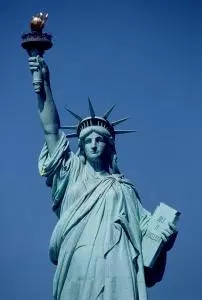
THE CRIMINALIZATION OF OUR AMERICAN CIVILIZATION (This Is Not A Manifesto)
C-Note: A poem, that’s been recognized on an international level.
DRPA: What inspired you to write this?
C-Note: A poetry contest, in which money and publishing came with it. It was put on by Outlawsonline.com. They wanted work that dealt with the life. That is the lifestyle that can lead one to prison, or about the prison or jail experience. They said the poem could be up to 3 pages long. Since this was a competition, “How was I going to distinguish myself from the others?” I decided to write a three-page poem on the theory no one else would.
DRPA: So did you win?
C-Note: Nah, didn’t get considered for nothing. It’s an epic poem that pays homage to Homer’s Iliad, and it’s a history of the United States with a criminal justice story woven in there. It’s been picked up, and commented on, all over the world, from the Ukraine, Indonesia, Singapore, just to name a few.
DRPA: I guess it was their bad.
C-Note: Obviously.
DRPA: You do music too.
C-Note: Yeah. We want to create prison Hip Hop. I have a saying, “Hip Hop ain’t dead, it went to prison.”
DRPA: So this song here or record, you have music?
Once Upon A Time…
C-Note: Yeah, you have two point two million Americans behind bars. If that were a city it would be the fourth largest, behind New York, Los Angeles, and Chicago, all known for very vibrant art scenes. Well it’s the same with prison. There is this saying I like to banter around. It goes, “For every beautiful flower that you see in the garden, there is another flower, of equal, if not of more beauty, deep, deep, deep, in the recesses of the forest that no one never sees.” I tell this to all the people who come and see us. Politicians, religious figures, Hollywood. Especially Hollywood, Joe Manganiello, Scott Budnick, just to name a few. I welcome them to our forest. When you come into this space of gun towers, administrators in suits, men and women guards in green, and men, convicts in blue, this is a lived experience. And they are going to give you a spill right at the front gate, that you know, has turned many right around and said, “That’s okay, I’ll wait in the parking lot.”
DRPA: That’s true. You guys were involved in a play that raised thousands of dollars.
C-Note: Correction, hundreds of thousands. My 2016 artistic endeavors have been involved in projects that have collectively raised north of $500,000. The 2017 fundraising projects I’m scheduled to participate in, I’m confident we’ll raise over a million dollars for prison reentry assistance and other prisoner related programs. So forget about that forest stuff, I’m pushing the “Oasis out in the desert.” This is a maximum-security prison and I’m riling up the population to get involved in the arts. But it’s tough. People got time on their hands so they are already doing art. They’ll tell you they are the greatest artist since the Hand of God’s creation. But when it comes time to perform, to produce, or exhibit, the low self-esteem around here is off the chain. It’s another story. And I don’t think people outside these walls truly understand the vapid self-esteem that prevades this environment. There is no Restorativeness in the American Criminal Justice System, but we have to find a way.
DRPA: Well we want to thank you for telling us your story.
C-Note: Alright, thanks. [Shakes hands]
C-Note receives top billing for his performance in “Birth of a Salesman.” A skit he wrote and starred in and was the opening act for the critically-acclaimed prison drama “Redemption in Our State of Blues.”
“Birth Of A Salesman,” C-Note’s painted rendition of his character Money Mike, in “Birth of a Salesman.” A role in which he morphed into so many characters, it prompted Hollywood actor Joe Manganiello to tell him, “I don’t think I could have pulled that off.”
Editors Note: C-Note, welcomes any correspondence with the public, and we encourage you to write to him:
Donald Hooker
CDCR# K94063
P.O. Box 4490
Lancaster, CA 93539
Photos courtesy of:
The Strindberg Laboratory
Peter Merts-Photographer
Fine Art America
Related Articles:
Where Are The African Americans?
Life Without the Possibility of Parole ( a prison play)
Major American Prisoner Art Exhibition on Alcatraz Isle
Father’s and Sons (A Play Written by Prisoners)
Edited by Donald “C-Note” Hooker and Mohammed White Ali
This post was originally published on this site be sure to check out more of their content



